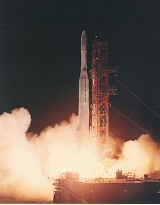
Delta M
Encyclopedia
The Delta M or Thor-Delta M was an American
expendable launch system
used for thirteen orbit
al launches between 1968 and 1971. It was a member of the Delta family of rockets.
The Delta M had a three stage configuration. The first stage was the Long Tank Thor, a stretched version of the Thor
missile, previously flown on the Delta L
. Three Castor-2 solid rocket booster
s were attached to the first stage to increase thrust at lift-off. A Delta E was used as the second stage, and the third stage was a Star-37D solid rocket motor. On the final flight, six boosters were flown instead of three, in a configuration known as the Delta M6, or "Super Six".
All thirteen launches were made from Launch Complex 17A
at the Cape Canaveral Air Force Station
. The maiden flight was on 18 September 1968, and carried the Intelsat 301 satellite. It failed to reach orbit after it went out of control and was destroyed by range safety
. The fifth flight also failed, leaving Intelsat 305 in an unusable orbit, due to a third stage malfunction. Of the thirteen launches, twelve carried geosynchronous
communications satellites. The thirteenth, which was the final flight and the only one in the M6 configuration, placed Explorer 43 into a highly elliptical orbit
.
United States
The United States of America is a federal constitutional republic comprising fifty states and a federal district...
expendable launch system
Expendable launch system
An expendable launch system is a launch system that uses an expendable launch vehicle to carry a payload into space. The vehicles used in expendable launch systems are designed to be used only once , and their components are not recovered for re-use after launch...
used for thirteen orbit
Orbit
In physics, an orbit is the gravitationally curved path of an object around a point in space, for example the orbit of a planet around the center of a star system, such as the Solar System...
al launches between 1968 and 1971. It was a member of the Delta family of rockets.
The Delta M had a three stage configuration. The first stage was the Long Tank Thor, a stretched version of the Thor
PGM-17 Thor
Thor was the first operational ballistic missile of the U.S. Air Force . Named after the Norse god of thunder, it was deployed in the United Kingdom between 1959 and September 1963 as an intermediate range ballistic missile with thermonuclear warheads. Thor was in height and in diameter. It was...
missile, previously flown on the Delta L
Delta L
The Delta L, Thor-Delta L, or Thrust-Augmented Long Tank Thor-Delta was an American expendable launch system used to launch the Pioneer E and TETR satellites in 1969 and HEOS satellite in 1972. It was a member of the Delta family of rockets.The Delta L was a three stage rocket...
. Three Castor-2 solid rocket booster
Solid rocket booster
Solid rocket boosters or Solid Rocket Motors, SRM, are used to provide thrust in spacecraft launches from the launchpad up to burnout of the SRBs. Many launch vehicles include SRBs, including the Ariane 5, Atlas V , and the NASA Space Shuttle...
s were attached to the first stage to increase thrust at lift-off. A Delta E was used as the second stage, and the third stage was a Star-37D solid rocket motor. On the final flight, six boosters were flown instead of three, in a configuration known as the Delta M6, or "Super Six".
All thirteen launches were made from Launch Complex 17A
Cape Canaveral Air Force Station Launch Complex 17
Cape Canaveral Air Force Station Space Launch Complex 17 , previously designated Launch Complex 17 , was a launch site at Cape Canaveral Air Force Station, Florida used for Thor and Delta rocket launches between 1958 and 2011....
at the Cape Canaveral Air Force Station
Cape Canaveral Air Force Station
Cape Canaveral Air Force Station is an installation of the United States Air Force Space Command's 45th Space Wing, headquartered at nearby Patrick Air Force Base. Located on Cape Canaveral in the state of Florida, CCAFS is the primary launch head of America's Eastern Range with four launch pads...
. The maiden flight was on 18 September 1968, and carried the Intelsat 301 satellite. It failed to reach orbit after it went out of control and was destroyed by range safety
Range safety
In rocketry, range safety is assured by the systems which protect people and assets on the rocket range in cases when a launch vehicle might endanger them. Range safety is usually the responsibility of a Range Safety Officer...
. The fifth flight also failed, leaving Intelsat 305 in an unusable orbit, due to a third stage malfunction. Of the thirteen launches, twelve carried geosynchronous
Geosynchronous orbit
A geosynchronous orbit is an orbit around the Earth with an orbital period that matches the Earth's sidereal rotation period...
communications satellites. The thirteenth, which was the final flight and the only one in the M6 configuration, placed Explorer 43 into a highly elliptical orbit
Highly Elliptical Orbit
A highly elliptical orbit is an elliptic orbit with a low-altitude perigee and a high-altitude apogee. It is a type of high Earth orbit....
.

